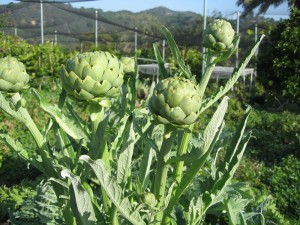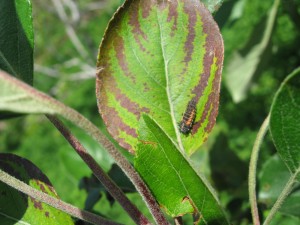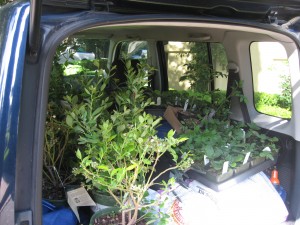Detoxing is what humans are designed to do in Spring. We eat more in winter in an attempt to keep the cold at bay, and we shed the accumulated toxins and excess weight in Spring. Mother Nature knows this, and so she gives us artichokes in Spring. Artichokes are full of natural beneficial chemicals, including cynarin and silymarin. Both of these compounds support the liver and the gallbladder in doing their jobs, cleansing the body of toxic stuff. Artichokes also help stabilize blood sugar levels, so they’re great for people with diabetes and hyperglycaemia. As you can see from the photo of this beautiful artichoke in my garden, they are basically the flowers of the most enormous thistles. The plant is pretty mean looking and gigantic, so the space to produce ratio is fairly slim. But boy, do they taste good!
Blog archive: April 2010
Ladybugs!
Or ladybirds… whatever you call them, they are a welcome sight to organic gardeners. They eat aphids (greenfly), and their larvae are even more voracious aphid eaters. The bug in the photo is a larva, and as you can see, it doesn’t look anything like the familiar adult insects with their bright red shells and black spots. Before they’re larvae, they’re yellow eggs
that are laid on the underside of leaves. You may have see these on organic lettuce bought from the farmers’ market, or if you’re lucky, you’ll see them in your garden.
I’m excited about this larva, because I released about 1500 ladybugs into the garden last week in the hope that some of them would create some. They prefer to be released late at night, so I decided to potter around the garden at 11 o’clock last Friday night, setting the scene for my insect friends to have a little romance. Et voila! It seems the plan worked, we have larvae! Which means less aphids for the citrus and apple trees to fight off.
Edible garden
Fresh for Spring 2010, I’m going to show you how I grow organic food in a home garden. Spring comes early here in L.A. As I write, it’s cloudy and overcast, around 60 degrees with a light breeze. Yesterday was the same, and tomorrow we’re expecting thunderstorms. But last week, it was very warm and sunny, and as soon as the storms have passed, it will be very warm and sunny again. Los Angeles isn’t quite the zero-seasons, constant sunshine location depicted in Hollywood myths, but it’s close. The sunshine is always close at hand.
And so I can plant summer crops now, confident that there’s absolutely no frost in sight. I’m planting a very first round of heirloom cherry tomatoes in red, yellow and black ready for small hands to reach out, pick and enjoy fresh from the vine. I’m planting Genovese basil to keep the tomatoes happy. When you plant tomatoes and basil together, both crops are tastier than if they had been planted in separate beds. They also protect each other from pests in a mutually beneficial arrangement that will ultimately lead to an awesome tomato basil sauce or tri-colore salad.
With the children in mind, I’m planting Alpine strawberries, a special wild variety with very small and tender fruits that are sweet sweet sweet… Alpine strawberries are a great reason to get planting. Even your local farmer’s market isn’t able to offer you these fragile gems. Their fragile skins and juiciness don’t allow the fruits to be transported further than from the plant to your mouth. In addition, I’m planting a few varieties of strawberries that bear giant fruit, just for fun. It’ll be cool to see baby Alpines on a platter alongside giant Fragrarias, especially with luscious organic cream on the side.
I’m excited about the blueberry bushes too. I’m planting a mixture of early ripening varieties which should be offering ripe blueberries for breakfast by early June. I’ve planted them shallowly, adding gypsum to the existing garden soil to loosen the clay clumps, and amending the soil further with an organic acid potting mix.
And last but not least, the tender greens bed. There’s a small area of ground that doesn’t get much sun, and I hate to see it lying empty. Lettuces and gourmet greens prefer to have some bright sunlight, which helps define their rich array of hues, but they’re content enough to make do with an area of soil that doesn’t get that much sun. I’m going to plant a bigger bed of lucky lettuces in another location, but for now, I’m planting this small shaded area with salad greens because it’s empty which won’t do, and because it’s right by the children’s favorite corner of the garden. They’ll be able to watch them grow quickly, because it takes between three and four weeks for them to grow from seed to totally eatable baby greens. Now that’s exciting!
Blog archives
- August 2015
- July 2014
- June 2014
- April 2014
- January 2014
- December 2013
- October 2013
- September 2013
- July 2013
- May 2013
- March 2013
- February 2013
- January 2013
- November 2012
- September 2012
- August 2012
- July 2012
- June 2012
- May 2012
- April 2012
- March 2012
- February 2012
- January 2012
- December 2011
- October 2011
- August 2011
- June 2011
- May 2011
- April 2011
- March 2011
- January 2011
- December 2010
- October 2010
- September 2010
- August 2010
- June 2010
- May 2010
- April 2010
- March 2010
- February 2010
- November 2009
- October 2009
- August 2009
- April 2009
- February 2009
- December 2008
- November 2008
- October 2008
- August 2008
- July 2008
- June 2008
- May 2008
- March 2008
- February 2008
- January 2008
- December 2007
- November 2007
- October 2007
- September 2007
- August 2007
- July 2007
- June 2007
- May 2007
- April 2007
- March 2007
- February 2007
- January 2007
- December 2006
- November 2006
- October 2006
- September 2006







